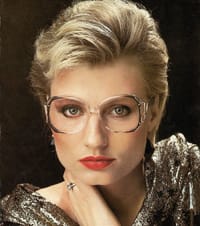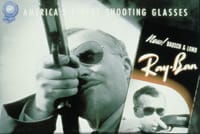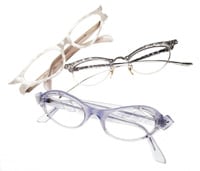The Vintage Advantage
The demand for vintage eyewear shows that everything old is new again
Joanne F. Schell
|
|
|
|
Some of the bolder styles of today take their cues from vintage frames, such as this 1960s model from Sàfilo USA. Photo courtesy of Sàfilo Group |
|
Allyn Scura, a designer and collector of vintage frames, was antique shopping in North Carolina when she came upon her first pair of vintage spectacles. She wore them as sunglasses in New York City and was met with many inquiries from people on the street, fascinated with her vintage frames.
Realizing there was an untapped market for vintage eyewear, she began to search out older frames to sell and hit the jackpot. She found and sold more than 5,000 unused pairs. A business success story was born: Scura has amassed a collection of more than 60,000 antique spectacles.
Selling and collecting vintage eyewear has become a passion for many eyecare professionals. Dating from the 1800s to the late 1980s, vintage frames offer the wearer a unique style and a piece of history.
"Since I started in the optical industry, I have been fascinated with the quality and craftsmanship of vintage frames," says Dale Thompson, owner and operator of Precise Eyeglass Repair in Cincinnati, Ohio. "They have an amazing amount of detail and character."
FRAME SEEKING
Finding vintage frames that are in "sellable" condition can be difficult. Used eyewear can suffer from a weak structure, making it an unworthy investment. "I always bought vintage frames at the flea market in Chelsea [New York]," says Scott Iseyama, partner at Allyn Scura Eyewear, a San Clemente, Calif.-based virtual retailer. "They would only last a few months at a time." Never-worn frames, he says, help to ensure that the frame can stand up to the stress of a lens installation.

|

|

|
The 1950s brought eyewear the introduction of the upswept temple. Shown here: a popular Tura frame from that decade
|
Inspired by artists such as Elton John, big and bold was one style of choice for the 1970s. This style is making a big comeback with the vintage crowd. Shown here: a vintage oversized acetate frame in bright yellow from Silhouette | Large frames with unique temple features were prominent in the 1980s. Shown here: ClearVision frame from that decade, style Sculptress |

|

|

|
| Above: Ray-Ban Aviators, still popular today, were introduced in 1937. | Robert Downey, Jr., popularized this oversized tortoise 1980s frame from Oliver Peoples. | Unworn vintage frames, such as these from the 1950s, are the best candidates for use today. Photo courtesy: Allyn Scura Eyewear |
|
|
|
Frame Foundations Dr. David Fleishman's Website, www.antiquespectacles.com, offers a historical recount of "eyewear through the ages," as well as thousands of photos and resources for collectors. Here is an excerpt from a timeline of the eyewear industry. 1286 Eyeglasses are made by a lay person in Pisa, Italy. 1300 The term eyeglasses is used for the first time. 1728 London optician Edward Scarlett is credited with developing side arms for spectacles (he is the first to advertise them). 1752 James Ayescough invents the double-hinged temple. 1760 Benjamin Franklin incorporates the idea of the split lens bifocal. 1825 George Airy corrects his own astigmatism with a pair of sphero-cylindrical lenses. 1886 American Optical produces the first ophthalmic lens in the United States. Decade Darlings Here's a list of vintage frames that are in high demand and the people that made them famous. 1920s Windsor frames--Mohandas Gandhi, Teddy Roosevelt 1940s Ray Ban Aviator frames (1937)--Air Force fighter pilots, General Douglas MacArthur 1950s Brow bar and thick black zyl frames--Buddy Holly; cat eye/harlequin frames--Marilyn Monroe, Ava Gardner, Rita Hayworth 1960s Plastic and metal frames--Malcolm X; Extra-large acetate frames--Jackie Kennedy Onassis, Audrey Hepburn 1970s Anglo-American tortoise frames--Andy Warhol, Robert Redford; Oversized zyl and metal frames--Elton John 1980s Large tortoise metal frames--Robert Downey Jr., Harrison Ford |
Most dispensaries that sell vintage eyewear deal in unused frames. Some frames can be found at antique stores, but to obtain a large stock, family-operated optical shops are often the best place to turn.
"Our biggest purchases are from people who had an optometrist in the family," says Jennie Wilson, owner of Vintage I Wear, an online dispensary.
"We get most of our frames from optical shops going out of business," adds Marilyn Welch of Ed Welch Antiques, a Maine-based dealer of vintage eyewear. "Dispensaries that have been around for 50 or more years might have an inventory of frames that could not be returned, and owners want to get rid of that inventory when they close."
Instead of actively pursuing the frames, many dispensaries post inquiries on the Internet.
VINTAGE VALUE
Once dispensers get their hands on enough frames, pricing issues have to be considered. Often, frames can be sold and melted down for reuse, so an interested ECP needs to make selling the frames to a dispensary a more attractive proposition. The first move for an ECP is to make an offer for the frames at a price that is above scrap value.
In terms of retail, the current structures of supply and demand determine the price, regardless of when the frames were produced.
"Like most businesses, pricing is based on what the market will bear," explains Iseyama. "This includes the impact of competitive products and consumer demand."
Sometimes, however, there are other issues to consider. "If a frame is incredibly rare, it's going to be more expensive," says Jamie Niblock, director of retail for Robert Marc, a New York-based dispensary and dealer of vintage frames.
"Gold-filled vintage frames are quite expensive because of the materials. Frames haven't been made like that since the gold standard changed in the 1970s," he adds.
OLD FRAMES, NEW LENSES
There are also some ophthalmic issues to consider when opting to service and sell vintage frames.
"Repair of vintage frames is very similar to modern frames; the quality of the repair is based on the expertise and skill of the repair technician," says Precise's Thompson.
"Unless you have specific information on when and where a frame was made, it may be hard to service or find replacement parts," adds Niblock.
Most people wear the frames for function. "People rarely ask about plano lenses," says Wilson. Making sure that today's lenses can be used in the older frames is key. For example, not all of today's high-index lens wearers can use older frames.
"Many vintage frames have prescription limitations," says Thomp-son. "With today's advances in high-index materials, the ranges of prescriptions have drastically increased.
For some older frames, edge thickness is a concern. And, as with some of today's glasses, smaller frames may not accommodate progressive lenses, but short corridor PALs help address the problem.
WHO'S LOOKING?
With more than 100 years' worth of eyewear available, the vintage eyewear market is hard to pinpoint.
"While it's still somewhat of a niche product, the label is as broad as pop music," Iseyama says.
Wilson gets most of her orders from the coasts--she also works with prop departments on plays and movie sets to fulfill costume needs.
Subculture groups may also make demands for period eyewear. Thompson's typical antique eyewear consumer might be a Civil War re-enactor, while Scura attracts Rockabilly enthusiasts who are immersed in a 1950s lifestyle.
On a broader scale, 1960s- and 1970s-style frames are making a comeback, as evidenced by the creation of new frames that nod to that mod-type style. Generally speaking though, the vintage eyewear enthusiast will have a collection of frames instead of a single multi-use pair.
"The person wearing vintage eyewear on the street might have something modern and classic at home as well," says Niblock. "It's an interesting time where people are seeking all types of looks."

|

|
| Hard-bridge and spring-bridge pince-nez frames date back to the 1880s. They are collectables more than usable vintage wear. | Pince-nez from 1880 through 1925 |
|
Resources |
For more information on antique and vintage eyewear visit these Websites: Antique Spectacles
Retrospecs
Ophthalmic Antiques International Collectors' Club
Ocular Heritage Society |




